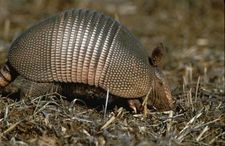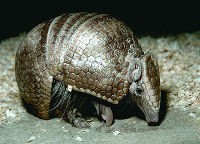
August 13, 2006

The nine-banded armadillo (above) is making inroads into the northern USA. Dasypus novemcinctus is most common in the central southern states, such as Texas, and abdundant in some parts of Florida.
If you run into armadillos in Missouri or southern Illinois, they are not cryptids or out-of-place animals. They are animals that are extending their range northward. As has been noted here briefly before (regarding birds and alligators), cryptozoologists need to keep track of this topic, so as to make certain we don’t confuse these natural range changes for “new animals” or folks’ sightings of bizarre and seemingly new animals as some kind of evidence of a cryptid.
Reporter Ken Leiser discusses the new northern march of this species in his article, “Armadillos have migrated north, and they’re ‘here to stay,'” in the St. Louis Post-Dispatch of August 13, 2006. Here’s the essence of what he says that impacts on our cryptozoological pursuits:
Armadillos began pushing into southern Missouri in the early 1980s, but sightings have been rare in St. Louis and surrounding counties until recently. The small armored animals had long been associated with warmer, Southern states but have shown they can adapt to winter temperatures in central Missouri and Southern Illinois.
“They are here to stay,” said Professor Lynn Robbins of Missouri State University.
Earlier this year, a Ladue woman was surprised to spot one of the nine-banded armadillos digging up part of her yard, said Tom Meister, a wildlife damage biologist for the Missouri Department of Conservation in the St. Louis area.
* * *
“They are becoming more and more common,” Meister said, particularly in Crawford and Washington counties, on the fringes of the St. Louis area.
* * *
There have been a growing number of armadillo sightings in Southern Illinois, especially in the last five years, said Clay Nielsen, a research scientist at Southern Illinois University Carbondale.
Since reaching Texas in the mid-1800s, the armadillo has pushed into the Southeast and now the lower Midwest. Despite the animal’s preference for warmer temperatures, Nielsen said “it is too early to say” whether global warming is contributing to the expansion.
“It has been a slow, gradual spread over a 150-year period,” Nielsen said.
Robbins’ research shows that the northern march has averaged several miles a year.
* * *
Robbins figured heavy snows several years ago would have knocked the population back, but the armadillos were present after the snow melted.
So far, Robbins said, they have weathered Missouri winters by sticking to places where ice and snow aren’t so heavy – like the edge of streams and beneath large trees. They rustle beneath leaf litter to find bugs, even in cold weather.
The critters are deceptively fast and can jump three to four feet into the air when startled. The most reliable evidence of their arrival is the occasional sight of an armadillo that has been hit by a car.
* * *
Two years ago, Missouri Department of Transportation maintenance workers in Franklin County weren’t seeing armadillos among the road kill they clear from highways. Now they see about one a week, said spokeswoman Linda Wilson.
By contrast, maintenance workers in the Department of Transportation’s 12-county region near Springfield, Mo., see them “every day,” said spokesman Bob Edwards. The sightings seem to increase each year.
* * *
I know one thing for sure. I would have enjoyed having some armadillos around when I took that 5 a.m. ornithology class at Southern Illinois University Carbondale in the late 1960s. Armadillos jumping 4 feet into the air might have kept me awake as we hiked around the woods looking for woodpeckers and songbirds and learning their Latin names. Unfortunately, today I live in apparently the only state, Maine, where it is illegal to own an armadillo, so there’s no keeping one as a pet here. Maine sightings of armadillos are zero.


Residents of South America, the Southern Three-banded Armadillo (Tolypeutes matacus) and the Brazilian Three-banded Armadillo (Tolypeutes tricinctus) are not the ones showing up in Missouri and Illinois, yet. If we start getting any reports of the Three-banded armadillo in Missouri and Illinois, spaceship Earth may be overheating a bit too much.
About Loren Coleman
Loren Coleman is one of the world’s leading cryptozoologists, some say “the” leading living cryptozoologist. Certainly, he is acknowledged as the current living American researcher and writer who has most popularized cryptozoology in the late 20th and early 21st centuries.
Starting his fieldwork and investigations in 1960, after traveling and trekking extensively in pursuit of cryptozoological mysteries, Coleman began writing to share his experiences in 1969. An honorary member of Ivan T. Sanderson’s Society for the Investigation of the Unexplained in the 1970s, Coleman has been bestowed with similar honorary memberships of the North Idaho College Cryptozoology Club in 1983, and in subsequent years, that of the British Columbia Scientific Cryptozoology Club, CryptoSafari International, and other international organizations. He was also a Life Member and Benefactor of the International Society of Cryptozoology (now-defunct).
Loren Coleman’s daily blog, as a member of the Cryptomundo Team, served as an ongoing avenue of communication for the ever-growing body of cryptozoo news from 2005 through 2013. He returned as an infrequent contributor beginning Halloween week of 2015.
Coleman is the founder in 2003, and current director of the International Cryptozoology Museum in Portland, Maine.
Filed under Breaking News, Cryptotourism, CryptoZoo News, Cryptozoology, Out of Place